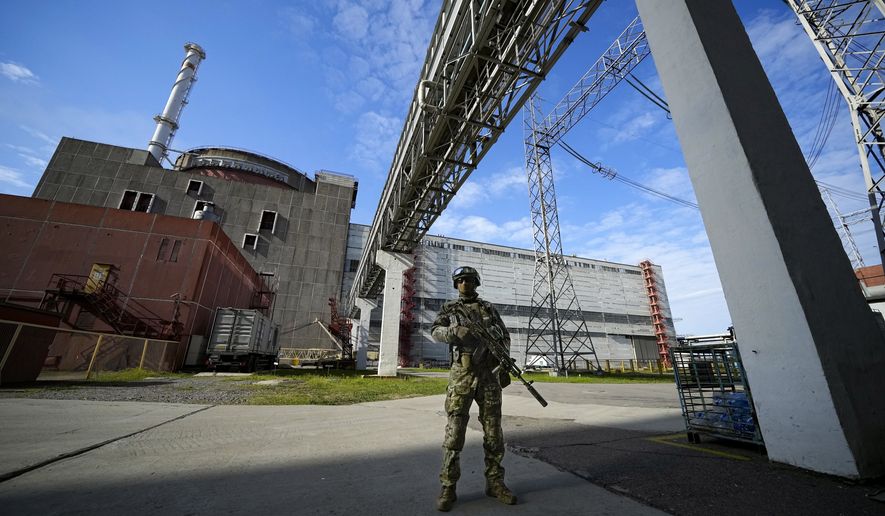Russia and Ukraine “are playing with fire” as fighting continues near the giant Zaporizhzhia power plant, the United Nations’ top nuclear inspector warned Tuesday in a plea for Moscow and Kyiv to immediately establish a safe zone around the site to prevent a potentially massive and deadly radiation leak.
A long-awaited report from the International Atomic Energy Agency and comments to the U.N. Security Council later in the day from IAEA Director-General Rafael Grossi painted a grim picture of the situation at the Zaporizhzhia facility, the largest nuclear plant in Europe.
Located on the front lines of the fighting in southeastern Ukraine, the plant is being run by Ukrainian civilian workers overseen by occupying Russian troops as the 6-month-old war started by Russia’s invasion rages nearby.
Inspectors who finally obtained access to the site in recent days say the facility has sustained significant physical damage. The plant is now relying on its internal power to run critical safety and cooling systems after losing access to outside electricity sources. Any major disruption to the facility’s power could lead to a Chernobyl-style disaster.
“The first important safety pillar that exists in any nuclear facility is not to violate its physical integrity, and unfortunately … this has happened. This happened and this continues to happen,” Mr. Grossi told representatives of the Security Council in an urgent address. “The physical attack, wittingly or unwittingly, the hits that this facility has received and that I could personally see, assessed together with my experts, is simply unacceptable.
“We are playing with fire, and something very, very catastrophic could take place,” Mr. Grossi said.
The IAEA chief and his 13-member delegation toured the facility last week. Their detailed report includes photos showing holes in the plant’s roof, apparently caused by shelling.
Moscow and Kyiv have traded blame for missile strikes on and around the plant, located on a reservoir on the Dnieper River. The Kremlin claims that Ukrainian troops have endangered the plant by trying to recapture it. Kyiv says Russia is essentially using the plant as a shield from which to launch attacks.
Seeking a cease-fire
Mr. Grossi did not assign specific blame to either side, but the IAEA report called on both armies to cease any and all fighting near the nuclear plant and to immediately establish a safe zone.
“While the ongoing shelling has not yet triggered a nuclear emergency, it continues to represent a constant threat to nuclear safety and security with potential impact on critical safety functions that may lead to radiological consequences with great safety significance,” the IAEA said in its report. “The IAEA recommends that shelling on site and in its vicinity should be stopped immediately to avoid any further damages to the plant and associated facilities, for the safety of the operating staff and to maintain the physical integrity to support safe and secure operation. This requires agreement by all relevant parties to the establishment of a nuclear safety and security protection zone around” the plant.
As the report was released, new violence near the plant underscored the danger of the situation.
The mayor of Enerhodar, the city where the plant is located, reported a major explosion. He said the blast left the city’s population of 53,000 cut off from power and water supplies, The Associated Press reported. It was not clear who was responsible for the explosion.
In Washington, State Department officials said they were assessing the report but called on Russian troops to immediately pull back from the facility.
“Fighting around a nuclear power plant certainly presents a serious risk, which is why we have continued to call for Russia’s immediate withdrawal from the facility. That continues to be our belief on that,” State Department spokesperson Vedant Patel told reporters.
While the two sides trade blame for violence near the plant, IAEA officials said there is increasing concern about the Russian military occupation at Zaporizhzhia and the impact on the staff. There are growing fears that the Ukrainians manning the plant are overworked and sleep-deprived, raising the risk of deadly human errors.
“Ukrainian staff operating the plant under Russian military occupation are under constant high stress and pressure, especially with the limited staff available. This is not sustainable and could lead to increased human error with implications for nuclear safety,” the IAEA report said.
Ukrainian officials said Russian troops are underestimating the gravity of the situation and acting irresponsibly.
“There are Russian troops now who don’t understand what’s happening, [who] don’t assess the risks correctly,” said Ukrainian presidential adviser Mykhailo Podolyak. “There is a number of our workers there who need some kind of protection, people from the international community standing by their side and telling [the Russian troops]: ‘Don’t touch these people, let them work.’”
Immediately after the IAEA report became public, Russian state-controlled media placed the blame squarely on the Ukrainian military.
“Energodar, which is the site of the Zaporozhye plant, Europe’s largest nuclear power facility, has been the target of shelling attacks by the Ukrainian military over the past few weeks,” the state-run Tass news agency reported. “When carrying out its strikes against the nuclear power plant, the Kiev regime is using drones, heavy artillery and multiple launch rocket systems. In most cases, the attacks are repelled by Russian air defense systems. However, some rockets hit the [nuclear plant’s] infrastructural facilities, including nuclear waste storage sites.”
• This article is based in part on wire service reports.
• Ben Wolfgang can be reached at bwolfgang@washingtontimes.com.




Please read our comment policy before commenting.